
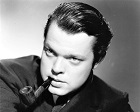 “The Black Museum. A Repository of Death. Here in the grim stone structure on the Thames which houses Scotland Yard is a warehouse of homicide, where everyday objects . . . all are touched by murder.”
“The Black Museum. A Repository of Death. Here in the grim stone structure on the Thames which houses Scotland Yard is a warehouse of homicide, where everyday objects . . . all are touched by murder.”
The Black Museum (1952) aired “A Lady’s Shoe” (in the United States and as near as historians can reasonably ascertain) on May 27, 1952. This is only the 10th episode we’ve run of this show since 2018 and the first since September 2021 over 2 years ago, so a bit of background is in order for newcomers to this sometimes grisly program. First of all, the name the Black Museum was coined in 1877 by a reporter for London’s The Observer newspaper, though the museum had opened in 1875 with the official name of simply the Crime Museum. It is the oldest museum in the world to display only artifacts of crime and is still known today by its official name of the Crime Museum despite the more colorful name given it by The Observer. The museum is not open to the public and is used primarily for instructional purposes for police training, but has had special visitors the likes of Sir Arthur Conan Doyle.
The Black Museum was one of four similar shows produced by Harry Alan Towers (1920-2009) under his Towers of London label in the late 1940s and early 1950s. Towers, a native born Britisher, would also produce popular radio fare like Secrets of Scotland Yard, Fabian of the Yard, and WHItehall 1212. All four shows centered around stories from the files of Scotland Yard, and New Scotland Yard’s famous Crime Museum, which was popularized in crime novels as the Black Museum. While all but Fabian of the Yard are verified as being produced and syndicated in Britain for future syndication, it is interesting to note that, according to the Digital Deli Too website entry, “WHItehall 1212 was a National Broadcasting Corporation production written by Lights Out’s famous scriptwriter Wyllis Cooper….” Three of the four shows, The Black Museum among them, would wrap their stories around an artifact from the museum, recounting in dramatic form the infamous crime associated with said artifact. Secrets of Scotland Yard kept to historical facts quite closely, and while a fascinating listen and quite popular, didn’t have the flair or melodramatic effect the likes of Orson Welles (1915-1985) would bring to The Black Museum as the host and narrator of each of its 51 episodes. And while The Black Museum also kept to the historical record surrounding each case, it would play a little fast and loose with them (or perhaps embellish them is the proper word) for dramatic effect, and it didn’t hurt that the show–unlike the others–drew its material solely from murders, thus guaranteeing the audience a chilling half hour. Overlay the grim stories with the somber, virtually hypnotic tones of Orson Welles and you’ve got a winner.

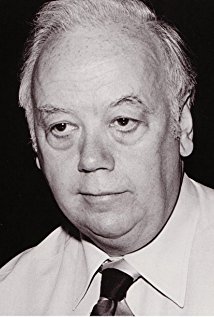 Speaking of Orson Welles, one might be given to wonder how he came to write some of, and host and narrate all of the episodes of The Black Museum, which were produced in the UK. It seems that Welles decided to take an extended “vacation” in England due to several professional and personal problems, including some “requests” from the Internal Revenue Service. So the American loss turned into Harry Alan Towers’s gain (Towers’s photo at left 1948, at right circa 1984), and he set Welles to work, a profitable solution for both parties. Welles would also work on two other Towers productions, perhaps the most well known to the American radio audience being The Lives of Harry Lime (or The Third Man.) The Third Man was a 1949 film noir British production set in post-World War II Vienna, with Welles playing the Lime character. Written by Graham Greene, it has attained classic status for its stylish portrayal of a decaying and corrupt Vienna, so Towers was striking while the iron was hot and rode the coattails of the film with Welles starring in the radio adaptation.
Speaking of Orson Welles, one might be given to wonder how he came to write some of, and host and narrate all of the episodes of The Black Museum, which were produced in the UK. It seems that Welles decided to take an extended “vacation” in England due to several professional and personal problems, including some “requests” from the Internal Revenue Service. So the American loss turned into Harry Alan Towers’s gain (Towers’s photo at left 1948, at right circa 1984), and he set Welles to work, a profitable solution for both parties. Welles would also work on two other Towers productions, perhaps the most well known to the American radio audience being The Lives of Harry Lime (or The Third Man.) The Third Man was a 1949 film noir British production set in post-World War II Vienna, with Welles playing the Lime character. Written by Graham Greene, it has attained classic status for its stylish portrayal of a decaying and corrupt Vienna, so Towers was striking while the iron was hot and rode the coattails of the film with Welles starring in the radio adaptation.
The airing of The Black Museum episodes presents problems for historians. Produced in 1950, it was first aired as a “pirate broadcast” by Radio Luxembourg, and then throughout Europe. It was eventually licensed by MGM Radio Attractions and ran in the United States under the Mutual Broadcasting System (MBS). MGM hand-picked what it considered to be the best 39 of the original 51 episodes and ran them from January 1, 1952 through December 30, 1952 (with a three month hiatus while a summer replacement filled the gap). This is the run from which we have taken “A Lady’s Shoe.” There’s more to the odd packaging and eventual airing of select episodes of The Black Museum (Canada’s CBC radio would also purchase some 38-39 episodes and air them at different times than the American run, for but one example), but all of that is neither here nor there for our current purposes.
This episode is about a middle-aged couple who are now newlyweds. The husband has bought his new bride a pair of shoes with which he hopes to impress his wife, even though she thinks they will look too young for her 40 years. Her husband convinces her otherwise and the marriage is off to a happy start. The wife is well off and they will be living in her 10-room cottage with the charming little moat surrounding the house, complete with a drawbridge that is mostly for show and cannot be raised. Marital bliss ensues, but soon cracks appear in their relationship when hubby makes untoward advances toward the newly hired housekeeper/servant girl. She quits, but when the same thing occurs to the new servant girl, the wife has had enough and leaves. Time passes beyond a reasonable amount for even an extended visit to friends, questions are asked, and even the local constabulary entertains doubts and smells foul play. Sometimes the devil is in the details and such is the case here where the object eventually landing in the Black Museum is simply labeled “A Lady’s Shoe.” I hasten to add that Orson Welles almost literally hypnotizes with his voice. He not only makes fantastic or horrific events into something beyond their Earthly essence, but mundane, quotidian slices of life as well. Which camp does murder fall into—the horrific or the mundane?
Play Time: 25:45
{Airing on a Tuesday evening in late May of 1952, the neighborhood gang couldn’t wait until after school the next day to meet at the corner newsstand to collect more hair-raising tales like “A Lady’s Shoe.” Detective Tales (1935-53) found a loyal audience which it maintained on a monthly basis until mid-1951, when it slowed down near the end of its run to a bi-monthly schedule. New Detective (1941-55) also had a solid run mostly as a bi-monthly, until its August 1953 issue, when it merged with the aforementioned Detective Tales to become Fifteen Detective Stories. Alas, under this bi-monthly title it would last only until June of 1955, whereupon it morphed into a men’s magazine titled True Adventures. This title would produce such fine literary gems as “Topless Chickeetas of Panama” and “Swedish Blondes in the Garden of Eden” to name but two. What began in 1941 as a crime magazine (New Detective) and would evolve into a general detective magazine in 1953 (Fifteen Detective Stories), would close shop in 1971 as a men’s magazine (True Adventures). The Phantom Detective (1933-53) began in response to the success of Street & Smith’s The Shadow magazine in 1931. Although it ended up publishing about half the number of issues as The Shadow (which published for many years 2 issues a month), The Phantom Detective made trips to the printer about half as many times, making it the longest-running single character pulp of all time. It was a quarterly in 1952.}
[Left: Detective Tales, 6/52 – Center: New Detective, 6/52 – Right: The Phantom Detective, Spring/52]
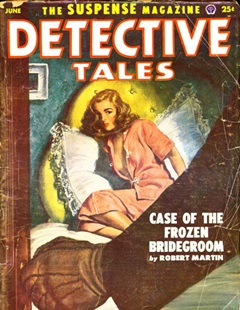
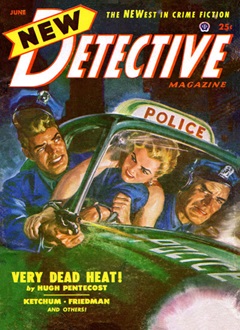
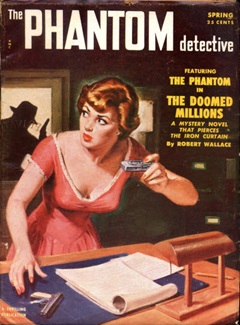
To view the entire list of weekly Old Time Radio episodes at Tangent Online, click here.